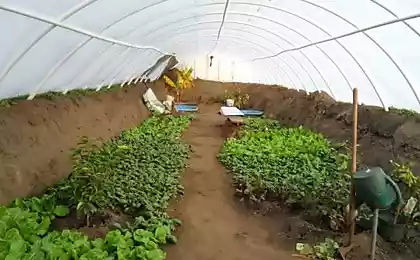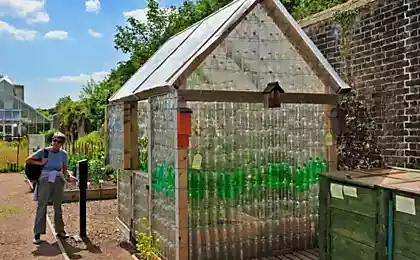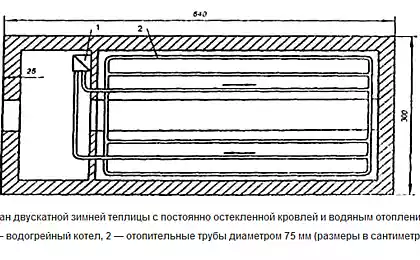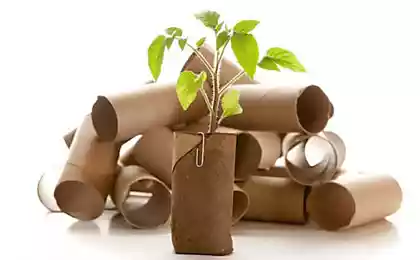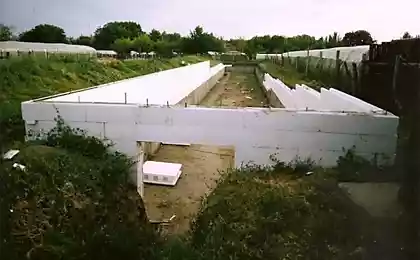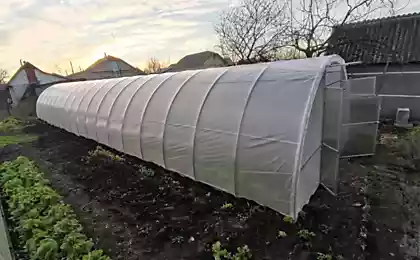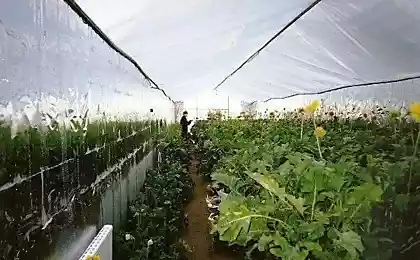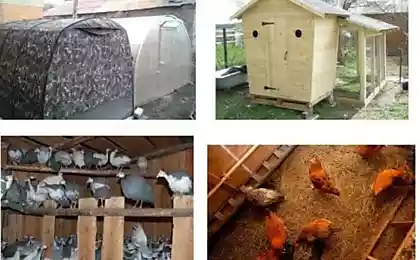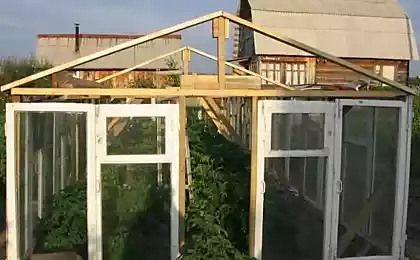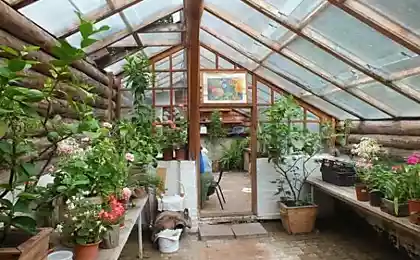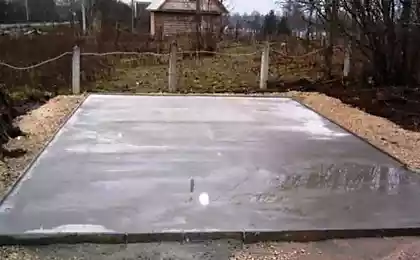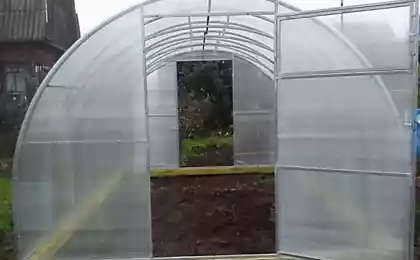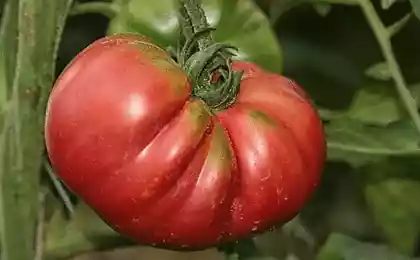611
How to choose the greenhouse — all You need to know
Stationary greenhouses are set on a regular basis, it can be installed on the Foundation. Mobile or portable greenhouse suitable for seasonal operation. To install and dismantle, it will need at the beginning and at the end of each season.
The frames of greenhousesof Metal
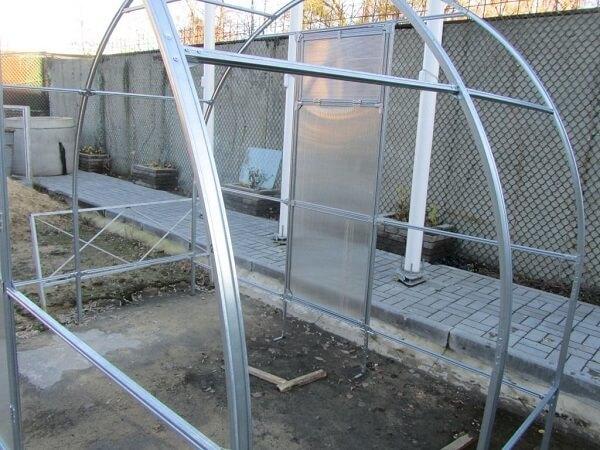
Fig. 1. Metal frame greenhouses
Metal frames are characterized by their strength and durability, do not require painting and Foundation, not rot, does not emit harmful substances, can withstand high loads. Rust and corrosion will prevent the treatment of special tools. The price of the metal frame is higher than wood, however, and the lifespan much longer. Lot of weight can be hard only the Assembly structure, but provides strength to operate. Installation of metal structures may require special knowledge and skills. Some types of metals have excessive softness (e.g., aluminum), it will require additional strengthening of the structure, which can reduce or block the internal space.
Wooden

Fig. 2. Wooden frame greenhouses
Wooden frames are short-lived, require impregnation with special products from fungi, decay defeated. Also the wooden frame imposes restrictions on the choice of the form of greenhouses and low moisture resistance will not allow to install the frame directly on the ground before sheathing his waterproofing materials. Building the wooden frame cost is inexpensive; the material is readily available, easy to handle and install.
Plastic PPR pipe

Fig. 3. Plastic frame greenhouses
A frame made of plastic pipes are very practical, no rust, no rot, needs no special treatment and painting, defies the negative impact of various fertilizers is possible to install the frame directly on the ground. Unlike metal and wood, plastic pipes are very flexible, which diversifies the possibilities of the greenhouse. The ease and availability of material greatly simplifies the Assembly design. However, due to the good flexibility of the plastic frame be more suited to greenhouses are small in size.
The relevant forms of greenhousesPolygonal
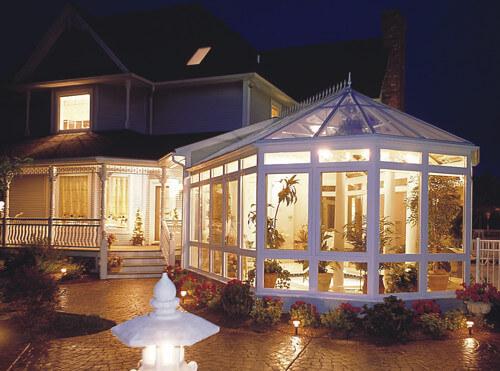
Fig. 4. Abstract greenhouse
Abstract a greenhouse at the expense of their faces is able to be heated at different times of the day. Mnogogrannost allows you to create an individual design of the greenhouse, even custom sizes for growing all types of plants. The Foundation and framework for such design shall be different better strength, which will increase installation costs, consumables and covering materials.
Gable
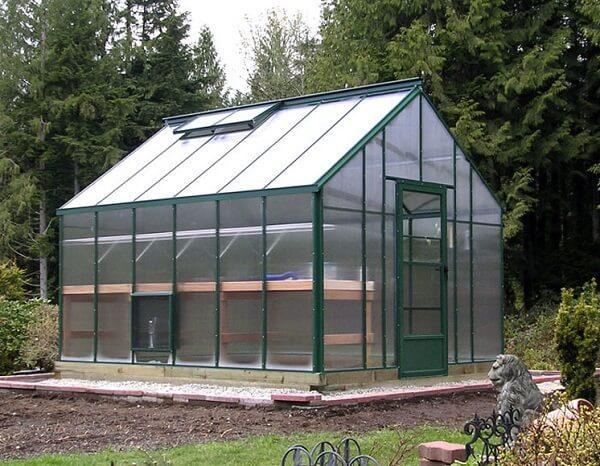
Fig. 5. Gable greenhouse
The design of this greenhouse the most common and is a "house" with straight walls, over which is a roof with two slopes. This design is easy to install and operate, provides the optimal illumination. Due to the shape of the roof is not created the increased load on the top. The volume of interior space will allow you to be inside in full growth and positioning of the landing on shelves and racks.
Arched
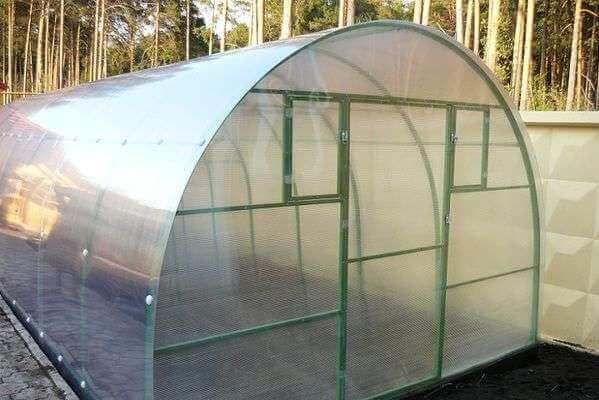
Fig. 6. Arched greenhouse
The lack in the design of sharp edges will save on consumables and covering materials. The frame of the greenhouse consists of semicircular arches, which are mounted on the vertical base, can be installed without a Foundation. Due to the streamlined shape, the greenhouse is resistant to environmental influences, easy to install and requires small amounts of compounds that has a low cost construction and provides a good penetration of sunlight. But the arch of the greenhouse functional, as they find it difficult to place shelves or racks. This form of greenhouse is more suitable for growing low crops.
Wall

Fig. 7. Wall greenhouse
Wall greenhouses are attached to the wall. This design will save space and reduce costs for consumables, making them the most economical option. This greenhouse is usually a shed roof. To equip the greenhouse wall must on the Sunny side, as the wall of the extension reduces the penetration of light.
Covering material for greenhousespolycarbonate
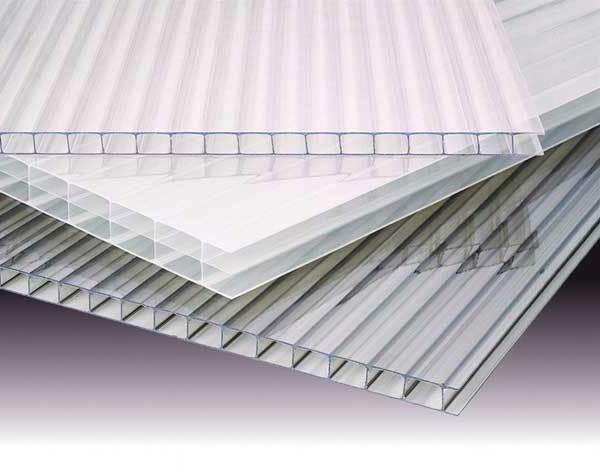
Fig. 8. Polycarbonate for greenhouses
Polycarbonate — available and very popular material. It has a special strength and durability, high resistance to weather conditions and environmental influences, not beating and not crack, is lightweight, easy to mount, has high thermal insulation and low thermal conductivity, fire resistant, has good light transmission, thus scatters light, is protected from UV rays. The material features allow you to create original designs of various types. However, light weight material requires a more durable frame and installation on the Foundation. Improper installation sheet (protection from UV rays inside) will significantly reduce the service life, and the hollow structure of the honeycomb is prone to penetration of water and dirt.
Plastic film
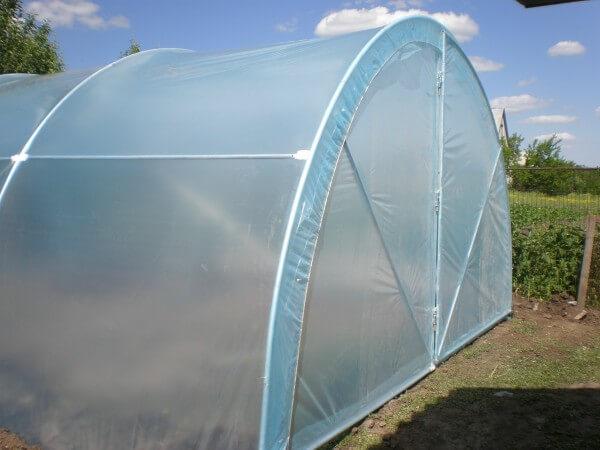
Fig. 9. Film for greenhouses
Plastic film is the most inexpensive covering material. Easy to install greenhouses of any shapes, transmits light well. However, the material is ephemeral, easily and adequately can last only one season.
Reinforced plastic film
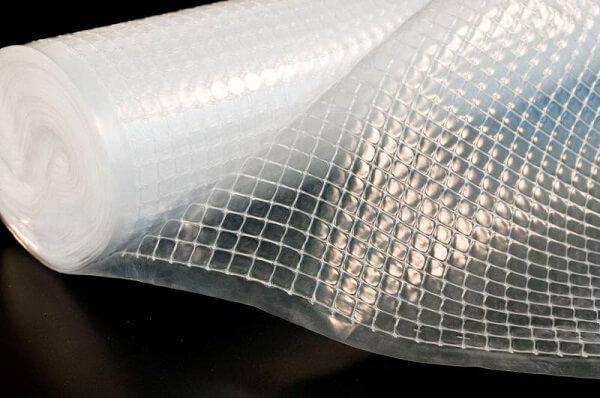
Fig. 10. Reinforced film for greenhouse
Reinforced plastic sheeting is more expensive than usual, but thanks to a special reinforced mesh is more sturdy and durable, will last for any season. In the same way as conventional film transmits light well, easy to install, suitable to many types of structures.
Glass

Fig. 11. Glass for greenhouses
Glass perfectly transmits light and has good thermal insulation, strength and durability. If not broken, will last more than one season. A large mass of glass requires more robust and reliable frame. The process of glazing is a complex business that entails additional expenses.
P. S. And remember, only by changing their consumption — together we change the world! ©
Join us in Facebook , Vkontakte, Odnoklassniki
Source: estp-blog.ru/rubrics/rid-24509/
The frames of greenhousesof Metal

Fig. 1. Metal frame greenhouses
Metal frames are characterized by their strength and durability, do not require painting and Foundation, not rot, does not emit harmful substances, can withstand high loads. Rust and corrosion will prevent the treatment of special tools. The price of the metal frame is higher than wood, however, and the lifespan much longer. Lot of weight can be hard only the Assembly structure, but provides strength to operate. Installation of metal structures may require special knowledge and skills. Some types of metals have excessive softness (e.g., aluminum), it will require additional strengthening of the structure, which can reduce or block the internal space.
Wooden

Fig. 2. Wooden frame greenhouses
Wooden frames are short-lived, require impregnation with special products from fungi, decay defeated. Also the wooden frame imposes restrictions on the choice of the form of greenhouses and low moisture resistance will not allow to install the frame directly on the ground before sheathing his waterproofing materials. Building the wooden frame cost is inexpensive; the material is readily available, easy to handle and install.
Plastic PPR pipe

Fig. 3. Plastic frame greenhouses
A frame made of plastic pipes are very practical, no rust, no rot, needs no special treatment and painting, defies the negative impact of various fertilizers is possible to install the frame directly on the ground. Unlike metal and wood, plastic pipes are very flexible, which diversifies the possibilities of the greenhouse. The ease and availability of material greatly simplifies the Assembly design. However, due to the good flexibility of the plastic frame be more suited to greenhouses are small in size.
The relevant forms of greenhousesPolygonal

Fig. 4. Abstract greenhouse
Abstract a greenhouse at the expense of their faces is able to be heated at different times of the day. Mnogogrannost allows you to create an individual design of the greenhouse, even custom sizes for growing all types of plants. The Foundation and framework for such design shall be different better strength, which will increase installation costs, consumables and covering materials.
Gable

Fig. 5. Gable greenhouse
The design of this greenhouse the most common and is a "house" with straight walls, over which is a roof with two slopes. This design is easy to install and operate, provides the optimal illumination. Due to the shape of the roof is not created the increased load on the top. The volume of interior space will allow you to be inside in full growth and positioning of the landing on shelves and racks.
Arched

Fig. 6. Arched greenhouse
The lack in the design of sharp edges will save on consumables and covering materials. The frame of the greenhouse consists of semicircular arches, which are mounted on the vertical base, can be installed without a Foundation. Due to the streamlined shape, the greenhouse is resistant to environmental influences, easy to install and requires small amounts of compounds that has a low cost construction and provides a good penetration of sunlight. But the arch of the greenhouse functional, as they find it difficult to place shelves or racks. This form of greenhouse is more suitable for growing low crops.
Wall

Fig. 7. Wall greenhouse
Wall greenhouses are attached to the wall. This design will save space and reduce costs for consumables, making them the most economical option. This greenhouse is usually a shed roof. To equip the greenhouse wall must on the Sunny side, as the wall of the extension reduces the penetration of light.
Covering material for greenhousespolycarbonate

Fig. 8. Polycarbonate for greenhouses
Polycarbonate — available and very popular material. It has a special strength and durability, high resistance to weather conditions and environmental influences, not beating and not crack, is lightweight, easy to mount, has high thermal insulation and low thermal conductivity, fire resistant, has good light transmission, thus scatters light, is protected from UV rays. The material features allow you to create original designs of various types. However, light weight material requires a more durable frame and installation on the Foundation. Improper installation sheet (protection from UV rays inside) will significantly reduce the service life, and the hollow structure of the honeycomb is prone to penetration of water and dirt.
Plastic film

Fig. 9. Film for greenhouses
Plastic film is the most inexpensive covering material. Easy to install greenhouses of any shapes, transmits light well. However, the material is ephemeral, easily and adequately can last only one season.
Reinforced plastic film

Fig. 10. Reinforced film for greenhouse
Reinforced plastic sheeting is more expensive than usual, but thanks to a special reinforced mesh is more sturdy and durable, will last for any season. In the same way as conventional film transmits light well, easy to install, suitable to many types of structures.
Glass

Fig. 11. Glass for greenhouses
Glass perfectly transmits light and has good thermal insulation, strength and durability. If not broken, will last more than one season. A large mass of glass requires more robust and reliable frame. The process of glazing is a complex business that entails additional expenses.
P. S. And remember, only by changing their consumption — together we change the world! ©
Join us in Facebook , Vkontakte, Odnoklassniki
Source: estp-blog.ru/rubrics/rid-24509/
